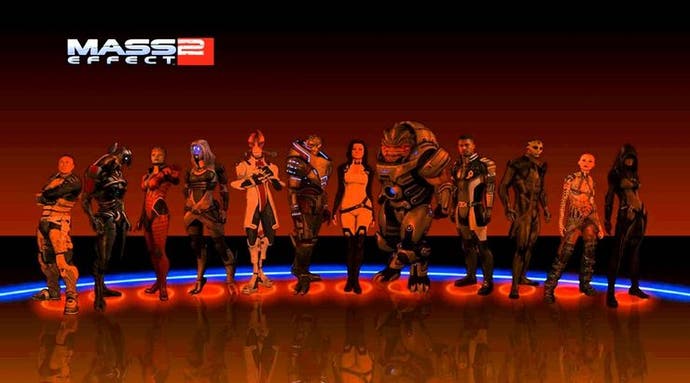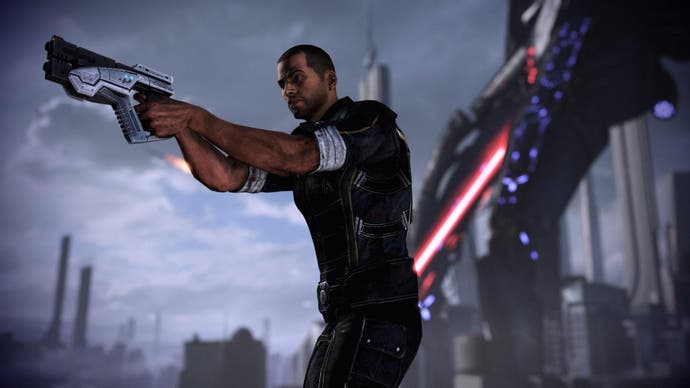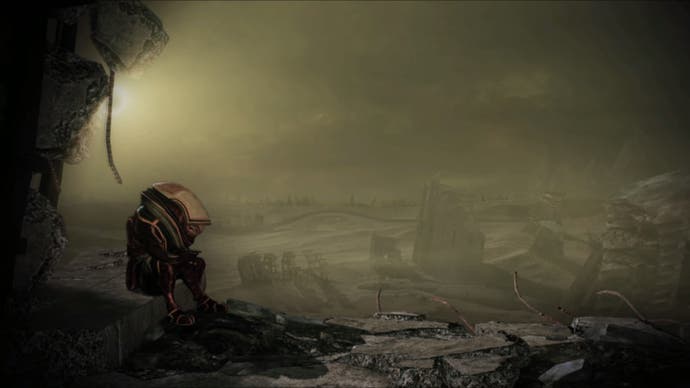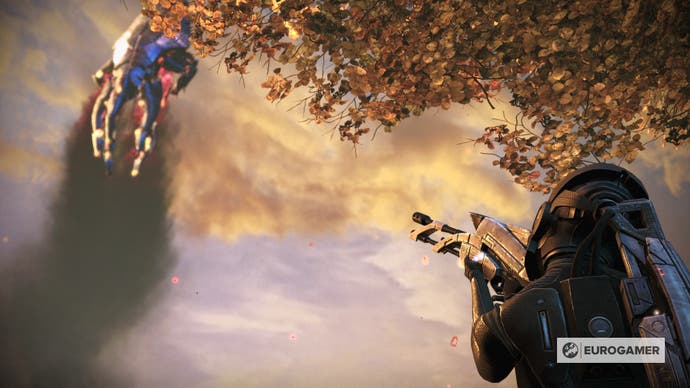Plotting a course: how Mass Effect 3 brought the trilogy to a close
BioWare talks scrapped Reaper boss, switched missions, and picking up the pieces after ME2's Suicide Mission.
Whatever you think of Mass Effect 3's final moments, it's fair to say BioWare's third chapter brought the trilogy to a close in style. Over the course of the game, every squadmate past and present gets their turn in the spotlight, major story arcs get revisited and tied off, and Shepard is prepped for their last big mission.
But how did BioWare begin planning Mass Effect 3? How much was set in stone already? And how did the studio start tackling the headache of (potentially) killing off everyone in Mass Effect 2's extraordinary Suicide Mission? To celebrate the release of Mass Effect: Legendary Edition, I sat down for an extended interview with lead writer Mac Walters to discuss how the game's story was set down - and some of the things which changed along the way. Read on for new details of cut ideas and swapped missions, plus an early idea for an Easter egg which would have ended the whole trilogy in the first half hour of Mass Effect 1.
Fair warning: if you've not yet played the Mass Effect trilogy, this article discusses plot points from throughout.
At the core of it all, Mass Effect 3 was designed to be about war. Fans had been waiting years for the Reapers to finally arrive - and BioWare knew it had to deliver a story shaped by a conflict now raging across the galaxy. Walters remembers printing off a Winston Churchill quote, laminating it, then sticking it up on the door of the BioWare's writing pit, where he and around eight other writers were beginning to break down the game's story.
"I just said, 'look, whenever we're thinking about any plot, whenever we're doing any sidequest, please remember, it's under this context', right?" Walters tells me. "So that was one aspect of the storytelling we knew had to be there. The other big thing we had to account for was the decisions in Mass Effect 2."
Those decisions, to be clear, can leave every squadmate and even Shepard dead - with only the death of the trilogy's hero considered non-workable, non-canon.
"I personally love that we took that risk," Walters says. "And we knew it was a risk. We always used to joke, like, 'this is a problem for our future selves!' There was any number of reasons not to do the Suicide Mission the way we did, to make it like, 'they died, but it's a Superman death and they're back to life now!', or where actually only these two people really die, and everybody else was, you know, maimed badly or something like that, and can recover. But no, we went all in on it."

I've written in the past of how Mass Effect 2's Suicide Mission is a fantastic piece of game design as it stands, though its narrative ripples throughout Mass Effect 3 make its legacy even more impactful. The third game had to respect its myriad of outcomes, but this also meant BioWare could not design Mass Effect 3 in the same way as its predecessor, where plot-heavy main missions were entirely dedicated to characters who may now be dead.
"It certainly shook up how we were going to handle coming from a game that was so focused on all the characters - many [Mass Effect 2] missions were about the characters themselves, whether it was their acquisition or their loyalty, and of course, the final sequence was so much about the relationships, and everything Shepard had done to make them loyal or not loyal, or who was best to do something. We knew we had to shake things up a little bit, because we kind of said, 'well, there's certain people who just aren't always going to be there. We can't depend on them as characters.' So it was going to be hard for us to tell a story around that."
BioWare had planned for this to some extent. Walters says it was always the intention that Mass Effect 3 would return to the Mass Effect 1 squadmates who largely sit out the trilogy's middle chapter, and were therefore safe from Suicide Mission death: Liara, and the remaining one of either Ashley or Kaiden. And it was always likely Mass Effect 3 would also introduce its own new squadmates, who ended up becoming James Vega, EDI, and Javik. Still, none of the character's main arcs were set in stone - even for characters whose story now seems indelibly linked to the trilogy's final chapter: Mordin, Legion, Wrex.
"The only arc we had any sense of going in would have been Shepherd's arc," Walters says. "This was Shepard's story, so it's going to conclude in some way. This is the story of a hero becoming a legend and then potentially becoming a martyr, throughout the course of the trilogy."

Work started with BioWare's traditional three-to-five page story document - "the core beats of the critical path", as Walters describes. "We'll throw in some of the characters we think will feature in that, but they're certainly not locked in stone. That really just is so we're happy with the main beats, the emotional beats in the game, we feel like the pacing is good. Then we start to break it out into the practicalities of building a game, where there's levels and missions. That's where a lot of the character development comes in, like, 'Oh, I think this would be a great mission for Samara or Miranda or whoever'. Part of what also makes it successful is we don't lock everything right away, we let it be a bit organic, we let things evolve. Then the job of the lead writer is how you weave it all together in a way where everything considers all the different ancillary things that are going on."
Squadmates - the characters Shepard spends the most amount of time with - were decided relatively early in the process due to the complexity of also building their animations and combat powers. "Certainly in the first year of development that would have been locked in," Walters says, calling Mass Effect's squadmates "one of the most expensive, outward facing features in any of our games... It's easy to write - writers get it easy! It's everyone else downstream, who then has to execute on that, and make it come to life."
Just as in Mass Effect 2 - where two of its squadmates ended up arriving later via DLC - Mass Effect 3 also planned to include another squadmate in its base game: Javik, the Prothean, who ultimately released as day one DLC. (After a negative response, BioWare has not released additional party members as DLC for any game since.)

"People will know Mass Effect 2 was originally the Dirty Dozen, but it only shipped with 10," Walters recalls. "And then the other two came in later. Javik, of course, infamously, was meant to be part of the main game in ME3, and we just couldn't... You know, you have to make those decisions, as you're going through and go, look, it's better that we deliver it after the game then not deliver it at all, or deliver everybody substandard.
"It's a long time ago now, but I believe he was always intended to be a squadmate," Walters says, when I ask if Javik's role changed when he became DLC. "But then we also had to make some adjustments to how you acquired him, and at what point he would join the story, as it were." When Mass Effect 3 finally launched, the DLC let players recruit Javik early in the game to allow him a spot on your squad as soon as possible. Still, though, the writers had to also account for him not being around, either.
When plotting out the game's acts, Walters and the writing team knew they had several big plot threads from throughout the trilogy that needed to be resolved. Or as Walters puts it: "the way the quarians have treated the geth and dealing with AI and everything there, that whole shemozzle of salarians basically bioengineering the krogan to not reproduce... For us, I think when you have this last chance to wrap up some moments in the trilogy, and some big questions, we knew those somehow had to play a part in that grander theme of the war."
As for the order of Mass Effect 3's missions, Walters says things changed quite often - even until relatively late. "If you look at the critical path missions in Mass Effect 3, and our file names, you'll notice weirdly, that 'CAT3' comes before 'CAT1'," he recalls. "I remember I was on vacation, and I was just reading through our arc and I went, 'this doesn't make any sense that this happens before this'. I mean, it made sense. But as a nice reveal and a beat, it made more sense to swap them. So we literally swapped wholesale two critical path missions in the order they happen chronologically."
After our interview, Walters went diving into his original design documents for more detail on what changed, and emailed back that the missions in question were Kai Leng attacking the Citadel, and Thessia - where you have a chance to fight Leng but which ends in Shepard being temporarily defeated. "In our first pass at laying out all the missions (after creating the story document), Thessia was CAT2 (Critical Path 2nd stage) - triggering after the genophage campaign, Citadel Attack was CAT3 - triggering after the geth-quarian campaign," Walters wrote. "But we ended up swapping them, mostly to build up Kai Leng's character a bit more - but also to bring the attack on the Citadel to the first half of the game/story.
"As a bonus - CAT1 was originally Prothean Acquisition (which became [Javik's DLC] From Ashes). This change was in two steps as I recall. First, the beginning of the game wasn't moving along quick enough, so we moved then-CAT1 to 'optional'. Then, when we were looking for some scope reductions, we had a mission that didn't necessarily have a home in our main story. It also gave us some added time to really flesh out Javik's character."

Many of the best missions in Mass Effect 3 - like the genophage arc which ends on Tuchanka - heavily feature choices made in previous games. This, just like the Suicide Mission outcome, provided further challenges for BioWare. "We tended to just think about what was best in the moment and not worry about the future," Walters recalls. "But one of the things we did to save our future selves was track almost every plot variable that would be worth tracking, even if you were not sure you would need it. A lot of times as you were developing ideas for a level mission, or even the whole game, you'd harken back to 'Oh, whatever did we do about that...?'
"Nassana is a great one. You know, when I wrote Thane in ME2 and his acquisition, I was like, 'I need a villain, I wonder if there was anybody who we already tangentially had in ME1 that we could use. Nassana didn't pop to me immediately, but as I was revisiting things I was like 'oh yeah, she wasn't real nice to me, it'd be nice if you had an opportunity to get back at her, right?' And then you kind of go, 'does it work?' If it does, you bring it in. I think the challenge with ME3 was ultimately for every mission we did, there were so many variables, and so many alternate endings. [On Tuchanka] it was Wrex or Wreav being alive or dead, you know, all of those things. But I love the way that mission really allowed you to trace back how consistent you'd been on some things to get the outcome you want."

One character some fans expected to play a larger role was Harbinger, the big bad boss Reaper. It gets just a cameo in Mass Effect 3's finale, where some hoped Shepard would shoot it in the face one-on-one. However, Walters reveals, there was once a plan for a kind of Shepard v Reaper fight.
"Originally when you're on the Citadel, there was supposed to be - remember the Reaper baby from ME2? Everyone remembers the infamous Reaper baby - a similar version of that, sort of manifesting itself on the Citadel," Walters recalls. "So when you confronted the Illusive Man, you were really confronting the Reapers and their embodiment of something on the Citadel. We actually had rough prototypes but ultimately, the ending, as most people remember, is extensive, it goes on, and it goes on. The typical thing to do would be a big boss fight, but it didn't feel right. It didn't feel appropriate for where we were."
BioWare has previously released concept art of a Reaper-fied Illusive Man, shown above, and said he too was part of a cut boss battle plan for Mass Effect 3's finale moments. But this Reaper fight was different, Walters confirms.
"There were two elements to it, that we concepted at various points. There was one where it was like, literally, instead of fighting the Illusive Man, the... not the arms of the Citadel, that's the wrong thing, but you would get this sort of giant octo kind of thing that you could fight. That's what we were trying. And of course, he [the Illusive Man] was somehow controlling it because his thing was control, control control. And so you're fighting something more akin to the Reaper baby, like some sort of large, mechanical thing.
"There were [also] concepts of the Illusive Man similar to Saren, in the vein of what happens to him after you shoot him the first time, or he shoots himself. That one probably went away a little sooner and then we switched to the other one... Ultimately, confronting the Illusive Man in the way that we did is a little bit more meaningful, certainly for his character than fighting some giant, disembodied extension of the Citadel that comes to life. Not to say we couldn't have done it and pulled it off and made it fun. I just think ultimately what we came up with was a better expression of who the Illusive Man was throughout the whole series."
So, no Shepard v Harbinger. But in one final tease, Walters recalls BioWare was originally planning a one-shot Reaper kill as an Easter egg - all the way back in Mass Effect 1, when you first glimpse Sovereign on Eden Prime.
"We had always joked about putting in the ability, when you first see Sovereign on Eden Prime, if you can snipe an exhaust port, you end the whole trilogy right there. We talked about doing it. We joked about it. Someone might have even... but it's not in, you'll never find it in the code. We always were just like, 'wouldn't it be great if you could just find the one exhaust port on Sovereign right at the beginning, snipe it, you know, probably have to be New Game+, as you'd have to be super steady. Game over, you win.'"
(I checked, just to be sure. It's not in there.)











